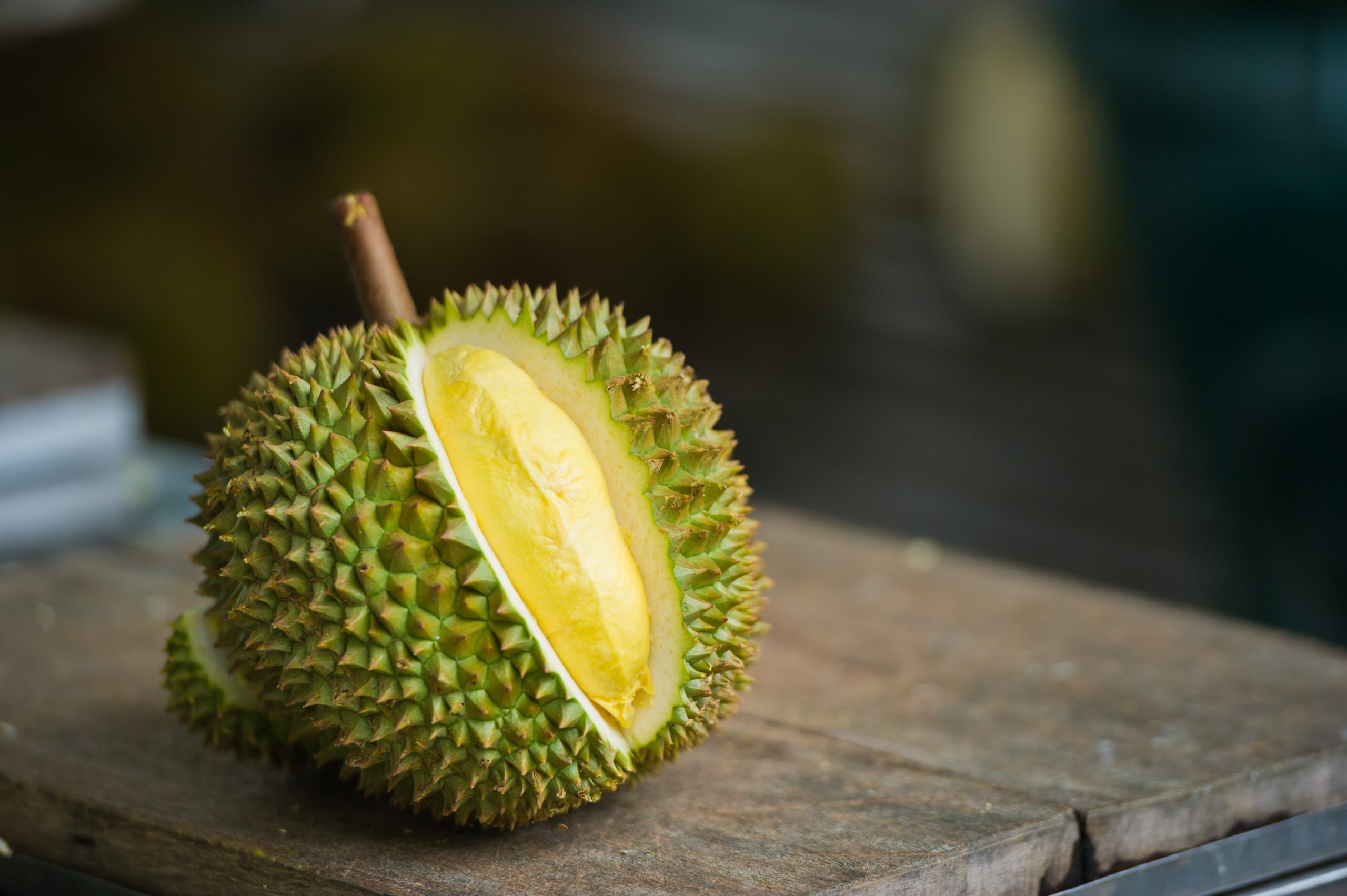Durian is spiky fruit native to Southeast Asia and is widespread in Thailand, Malaysia, the Philippines, and Indonesia. Despite its divisive aroma, durian has a dedicated following of fans who love its creamy texture and complex flavor.
Table of Contents
What is a Durian?
Durian (Durio zibethinus) is a tropical fruit believed to have originated in Sumatra and Borneo. It is a large spiky fruit, typically weighing between 2 to 7 pounds, and is known for its pungent smell and unique flavor.
The name “durian” is believed to have originated from the Malay word “duri,” which means thorn, referring to the sharp spines covering the fruit’s outer layer.
The edible fruit is pronounced as “doo-ree-ahn” or “doo-ree-en” and is part of the Malvaceae family. Its hard, thorny husk has a creamy yellow or orange interior. The flesh is divided into segments and has a custard-like texture, with a large seed in the middle of each segment.
Durian has a distinct aroma compared to a combination of cheese, onions, and turpentine, which some people find unpleasant. But the opinions are varied when it comes to its taste.
The fruit’s smell is so strong that it is banned on planes, public transportation, and many public places in Southeast Asia. However, those who enjoy the fruit describe the flavor as rich and creamy, with a sweet and slightly nutty taste reminiscent of custard.
Durian is commonly eaten fresh but can also be used in various dishes like ice cream, cakes, and candies. It is a popular ingredient in many Southeast Asian cuisines and is sometimes called the “king of fruits” due to its unique flavor and texture.
There is a widespread belief that consuming durians and alcohol together can be a fatal combination that may result in death. However, this turns out to be a myth. There is no definitive scientific evidence to support this claim. Nonetheless, excessive consumption of durians may lead to heartburn and bloating due to the fruit’s high fiber and carbohydrate content.
There are some varieties of durian, but the most popular one in Malaysia is Musang King.
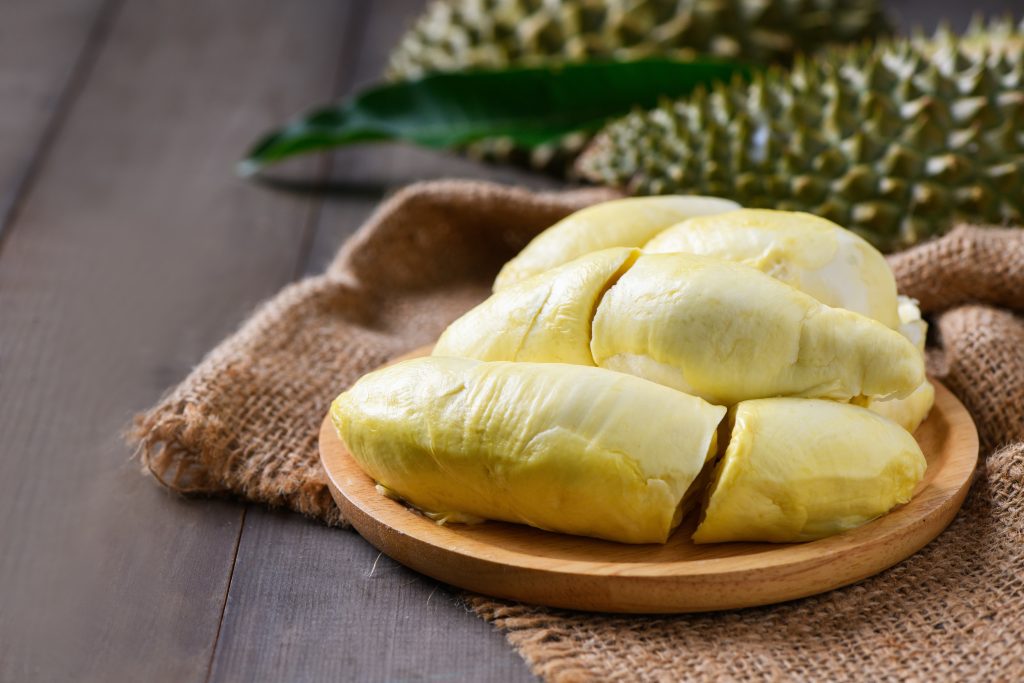
The History of Durian
The durian fruit has been consumed in Southeast Asia for a long time, even before recorded history. However, the Western world only became aware of it a few hundred years ago.
Niccolò Da Conti, who traveled to Southeast Asia in the 15th century, was one of the first Europeans to document the durian fruit. He described it as a large green fruit with a buttery texture and a combination of flavors.
Later, in 1741, the German botanist Georg Eberhard Rumphius provided the most detailed and accurate account of durians in his book “Herbarium Amboinense.” He also created the genus Durio, which has a complex taxonomy with many species being added and subtracted over time.
In Singapore, Lorong Lew Lian Street was named after the durian fruit in 1956. The Hokkien dialect word for durian is “lew lian.” Durians are very beloved in this area, especially during the peak of durian season.
What Does a Durian Taste Like?
Regarding taste, Durian might be the most controversial fruit out there! That is because it has a unique flavor and aroma that is difficult to describe. Some people love it, while others find its taste and smell repulsive.
Many people describe the taste of durian as sweet and creamy with a hint of bitterness. Others describe it as having a strong onion or garlic flavor. Some people also describe it as having a custard-like texture, similar to a ripe avocado.
The durian aroma is also powerful and distinct; many people find it unpleasant or nauseating. Some compare its smell to rotten onions, while others describe it as having a fruity and sweet taste with hints of caramel or almonds. And finally, some say it tastes like smelly gym socks or rotten eggs.
Alfred Russel Wallace described the taste of the durian as “a rich custard highly flavored with almonds.” The smell of Durian has also been described as “the smell of death” and “a cross between turpentine and rotting trash. So, as you can see, opinions vary tremendously.
How to Tell When Durian is Ripe
To determine the ripeness of durian, look for these characteristics:
| Color | The color of the durian’s spiky exterior turns from green to yellowish-brown, indicating that the fruit is ripe. |
| Cracks | Check for the presence of cracks or splits on the durian’s skin. These suggest that the fruit is fully matured and ready to be consumed. |
| Scent | Ripe Durian will have a strong and pungent smell. This smell can be overpowering and unpleasant for some people, but it is a clear indicator of ripe fruit. |
| Texture | The flesh of the durian should be soft and creamy. Gently press the flesh with your fingers to check for its texture. |
Are Durian and Jackfruit Related?
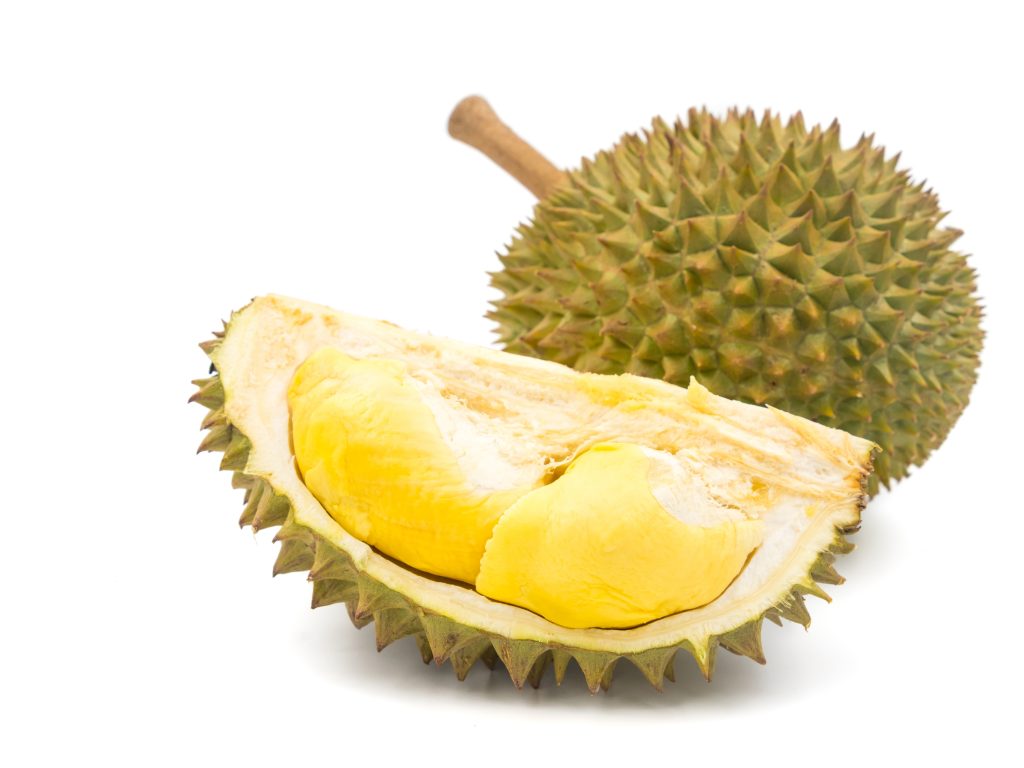
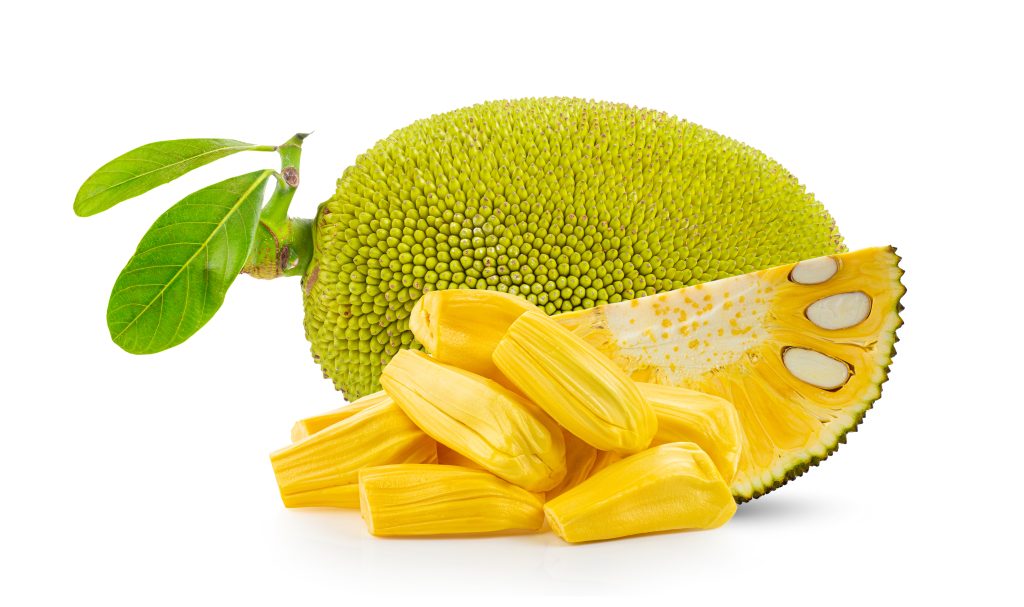
Durian and jackfruit are different tropical fruits that may seem similar to some people because of their spiky exteriors. They both are tropical fruits commonly found in Southeast Asia – and typically in sweet and savory dishes in these cuisines.
However, these fruits come from different families and have some notable differences.
| Family | Durian belongs to the Malvaceae family, while jackfruit belongs to the Moraceae family. |
| Appearance | Durian has a spiky exterior with a greenish-brown color, while jackfruit has a bumpy surface with a green or yellowish color. |
| Size | Durian is generally smaller than jackfruit, with an average weight of 1-3 kilograms, while jackfruit can weigh up to 35 kilograms. |
| Taste | Durian has a pungent odor and a creamy, custard-like texture with a sweet and slightly bitter taste. Jackfruit has a milder scent and a fibrous, meaty texture with a sweet, fruity flavor. |
Can I Eat Raw Durian?
Durian is generally safe to be eaten raw, but it is important to note that the fruit has a powerful smell and flavor that not everyone may enjoy. Additionally, some people may be allergic to durian, so it’s best to test a small piece when first eating it.
Whether you eat durian raw or cooked is up to personal preference. Some people enjoy the strong flavor of raw durian, while others prefer it cooked in a dish such as a durian cake or ice cream.
Cooking with Durian
Although commonly eaten fresh, durian is also an ingredient in many sweet and savory dishes. If you want to cook with durian, the first step is to know how to prepare it.
- Choose a ripe durian. You can tell that durian is ripe when its spiky skin has turned yellow or brown and emits a pungent smell.
- Using a sharp knife, cut a shallow incision around the middle of the fruit, following its natural seam.
- Gently twist the two halves in opposite directions to open the fruit.
- Use your hands to remove the durian flesh from the pods, discarding the seeds and any fibrous parts.
- Use a spoon or fork to scoop the flesh from the pods and place it in a bowl.
Durian is typically used in Malaysian, Thai, Indonesian, and Filipino cuisine.
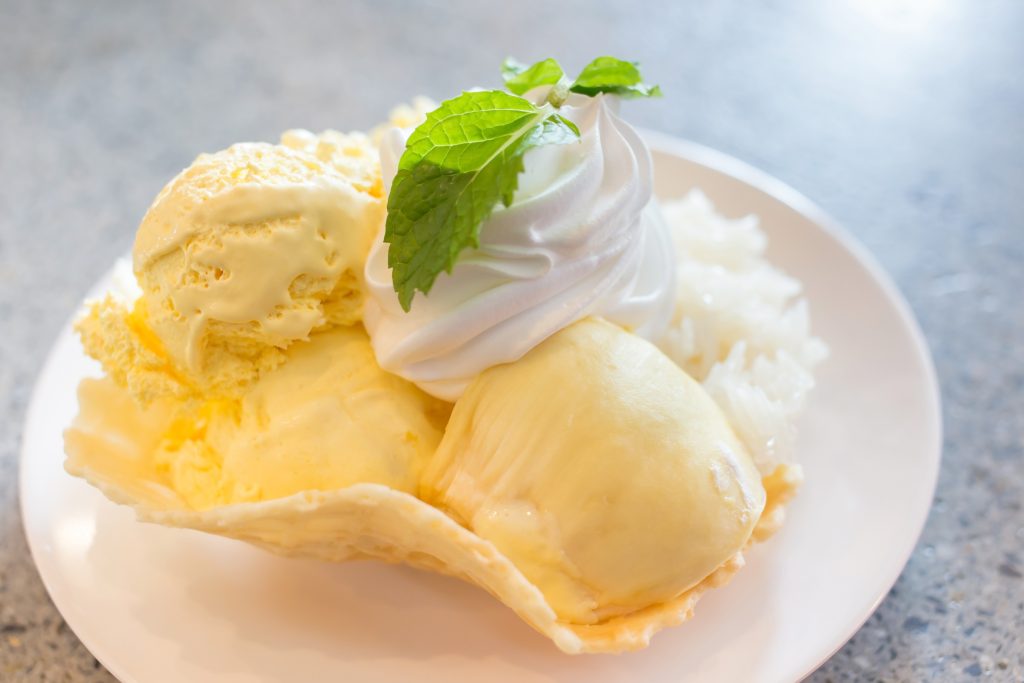
Now that you know a thing or two, here are some specific dishes that you can try:
Durian Dodol: This is a popular sweet treat in Indonesia and Malaysia, and it’s made with durian flesh, rice flour, and coconut milk. The result is a creamy, sweet dessert perfect for cooling off after a spicy meal.
Laotian Sticky Rice with Durian: This dish combines the best of East Asian cuisine with this famous fruit. And it only has four ingredients, so it’s straightforward to make.
Durian Cream Crepe Pancakes: These are an indulgent way to start or end your day! They’re made with crepes filled with creamy durian. It may sound strange at first glance, but it will leave your taste buds wanting more!
Durian Ice Cream: This recipe is precisely what you’d expect from an ice cream made from this exotic fruit: sweet, creamy, and full-bodied—just like its namesake!
How to Store Durian
Durian can be stored in the refrigerator for 1-2 days. Place the fruit in an airtight container or wrap it tightly with plastic wrap to prevent odors from permeating other foods in the refrigerator. Keep the durian in the fruit and vegetable compartment of the fridge, as this area maintains the right humidity level.
You can also freeze durian to extend its shelf life. Cut the fruit into small pieces and place them in an airtight container or a freezer bag. The frozen durian can be stored for up to 2 months.
Nutritional Benefits of Durian
Durian has a wide range of health benefits. First, it is packed with vitamin C, which has antioxidant properties that can help fight free radicals in your body, reducing wrinkles and pigmentation.
Durian is an excellent dietary source of potassium, an electrolyte that helps regulate blood pressure levels, keeping your blood pressure in check. It also contains tryptophan, which helps increase melatonin levels, a hormone that regulates sleep cycles.
This fruit’s iron, copper, and potassium can increase bone density and promote bone health.
Curiously, durian can also make you happy. That’s because it contains tryptophan, an amino acid converted into serotonin, a neurotransmitter that makes us feel happy and relaxed.
When you need an energy boost, consider snacking on a durian seed. Durian is high in carbohydrates and can provide a quick energy source, similar to a medium-sized banana.
Where to Purchase Durian
In some areas with a large Asian community, farmers’ markets may sell fresh durian during the season. Durian is typically in season in Southeast Asia from June to August, although the specific season can vary depending on the country and region.
Outside of Southeast Asia, durian can usually be found year-round in specialty stores and imported from Southeast Asia. Depending on the location and season, these stores may carry fresh or frozen durian.
You can also purchase durian online from websites specializing in Asian foods and fruits. However, be aware that public transportation of durian can be challenging due to its strong odor, so buying from a reputable seller who can package it properly is crucial.

